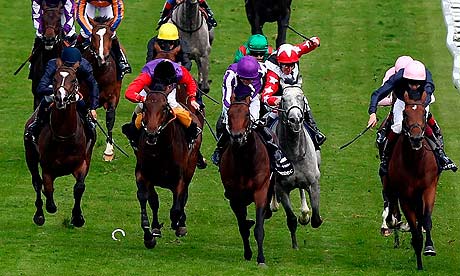 |
| "It's not funny!" this horse seems to be saying and there's no question that most horses are less than amused at the prospect of wearing muzzles. Would it be different if all the horses in the pasture had to wear them? This expressive photo is by the talented animal photographer Judith Whelan. |
New research, presented at the Equine Science Society (ESS) Symposium in Nashville, Tennessee last month, shows that using a grazing muzzle can reduce the pasture intake of ponies by over 80 percent.
When horses and ponies, in particular, are given free access to grass, they appear to be more susceptible to obesity and related disorders, such as insulin resistance and laminitis, than are those with restricted access to grass.
However, simply reducing the amount of time a horse or pony is allowed to be out at pasture may not be as effective as previously thought. Another study, also presented at the ESS meeting, has shown that ponies may adapt their grazing behavior to eat more in a shorter time.
The new research shows that the use of a grazing muzzle could be a much more effective and reliable solution if used appropriately.
Grazing muzzles significantly reduce bite size and intake. Anecdotally, ponies fitted with grazing muzzles spend a greater proportion of time engaging in foraging- and eating-directed behaviors than their non-muzzled counterparts, yet they still either lose weight or retain an established, trim body condition.
The study, which was conducted by the British-based Waltham® Equine Studies Group in collaboration with Dr Annette Longland of Equine Livestock and Nutrition Services in Wales, aimed to quantify the effect of wearing a grazing muzzle on herbage intake by ponies.
Four mature ponies were recruited for the study. After an adaptation period, their pasture intakes were determined when wearing a grazing muzzle and when grazing without a muzzle. Pasture samples were obtained daily to assess the grazing available. Insensible weight loss (ISWL) was determined for each pony immediately preceding and immediately following each three-hour grazing period. Intakes were determined by changes in body weight (after taking into account the weight of any feces and urine produced plus the estimated ISWL) after the three hours of grazing, using a calibrated weighbridge.
Pasture intake by the ponies grazing for three hours without muzzles averaged 0.8 percent (with some eating close to 1 percent) of their bodyweight. This is the equivalent of up to two-thirds of the recommended daily dry matter intake for many ponies on restricted diets.
Owners therefore may under-estimate pasture intakes of un-muzzled ponies, even when they are provided with restricted time at pasture.
In contrast, the pasture intake of the ponies when wearing muzzles was around 0.14 percent of bodyweight over three hours, representing an average reduction of 83% percent compared to when they were not wearing muzzles.
Clare Barfoot RNutr, is research and development manager at Spillers®, a British feed company. Her comment on the research: “These figures clearly show how effective grazing muzzles appear to be as a method to restrict pasture intake. The study has given us helpful, practical guidance on how we can safely manage grass intake to control weight gain and reduce the risk of obesity-related disorders, without significantly compromising the natural behavior and wellbeing of our horses and ponies.”
Grazing muzzles must be used with care, should be properly fitted and horses and ponies should be adapted gradually to wearing them. Group and individual behavior should be monitored closely to observe any potential concerns caused by changes to the herd dynamics. Total exclusion muzzles are not advised.
Reference for this research:
A Longland, ELNS, Pantafallen Fach, Tregaron, SY25 6NG, P Harris, WALTHAM Centre For Pet Nutrition, C Barfoot, Mars Horsecare UK Ltd, Old Wolverton, Buckinghamshire UK. (2011) The effect of wearing a grazing muzzle vs not wearing a grazing muzzle on pasture dry matter intake by ponies. J Equine Veterinary Science 31: 282-283
Additional reference for research mentioned in this article:
J. Ince, Institute of Biological, Environmental and Rural Sciences (IBERS). Aberystwyth University; A. Longland, ELNS, Pantafallen Fach, Tregaron, SY25 6NG C. J. Newbold, Institute of Biological, Environmental and Rural Sciences (IBERS). Aberystwyth University & P. Harris, WALTHAM Centre For Pet Nutrition.(2011) Changes in proportions of dry matter intakes by ponies with access to pasture and haylage for 3 and 20 hours per day respectively for six weeks. J Equine Veterinary Science 31: 283
 | ||
| Click here! Rev up your knee-to-hoof anatomy knowledge with the 3-D animation study tool everyone's talking about! Easy to order! |
© Fran Jurga and Hoofcare Publishing; Fran Jurga's Hoof Blog is a between-issues news service for subscribers to Hoofcare and Lameness Journal. Please, no use without permission. You only need to ask. This blog may be read online at the blog page, checked via RSS feed, or received via a digest-type email (requires signup in box at top right of blog page). To subscribe to Hoofcare and Lameness (the journal), please visit the main site, www.hoofcare.com, where many educational products and media related to equine lameness and hoof science can be found. Questions or problems with this blog? Send email to blog@hoofcare.com.
Follow Hoofcare + Lameness on Twitter: @HoofcareJournal
Read this blog's headlines and read special Facebook-only news and links when you "like" the Hoofcare + Lameness Facebook Page
Disclosure of Material Connection: I have not received any direct compensation for writing this post. I have no material connection to the brands, products, or services that I have mentioned, other than Hoofcare Publishing. I am disclosing this in accordance with the Federal Trade Commission’s 16 CFR, Part 255: Guides Concerning the Use of Endorsements and Testimonials in Advertising.












